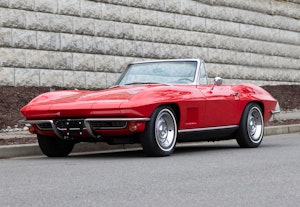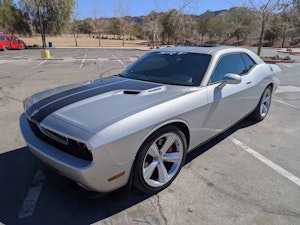Media | Articles
Dorothy Deen
It’s such a manly-man feeling, we tell ourselves, driving along in a black TR3. With the wind buffeting around the wind wings, and with arms hanging over the low cut doors, one can feel kind of tough. Not Harley-Davidson tough, but, well, a little tough. But if you’re a guy, don’t forget that your black Triumph was almost painted a lovely pastel, and that you should thank a pretty tough lady for the car being sold in America.
Dorothy Deen was one of those influential business people who saw an opening in a market for something they themselves are interested in, and who have the savvy to capitalize on it. In her case, it was Triumph sports cars in the 1950s, a time when a foreign car meant a Beetle, and a sports car meant an MG.
Born in southern California in 1922, on what was then a farm but is now in the heart of Los Angeles, Dorothy learned about cars and business from her father, Arthur Andersen, who was a respected engineer. Among his many projects, Andersen developed Whizzer engines, which could be used to power bicycles. As a teenager, Dorothy would go on extended tests of the Whizzer engines, and like any test driver, would sometimes have to diagnose problems in the middle of a run just in order to get back home.
Competition and collaboration with her father would shape much of Dorothy’s career. When he needed to fly to England for business, she asked to go. He said she could if she could get a passport before they left, which was to be in a day. He figured he’d be flying alone, but persuasion was a talent of Dorothy’s and she managed to have a State Department employee expedite her request, and accompanied her stunned father on his trip. She would later market small model airplane engines made by her father by placing ads in Popular Mechanics and Popular Science, made a decent mail order business until her father sold his end of the production.
When Dorothy bought an MG-TD and her father bought two Morgans, another venture was born. California car culture had a little subset around early MGs, and people would attend rallies and gatherings, but no one could get little accessories to personalize their cars. Dorothy’s father decided to have one of his machinists manufacture some accessories such as wind wings, luggage racks, and sun visors. Dorothy became sales and marketing manager of their newly formed business – Cal Specialties. She called her line of accessories “Doretti” a sort of Italian-sounding corruption of “Dorothy.”
Marketplace
Buy and sell classics with confidence
While Dorothy’s business grew, so did her father’s interests. He began working with Tube Investments, a manufacturing business in England. Through connections with Tube Investments, Andersen was able to meet with Sir John Black of Standard-Triumph, and all agreed that Andersen and Dorothy would import TR2s, as well as a new Triumph-based sports car that Tube Investments would develop. The new sports car would be called the Swallow Doretti, a name that Dorothy sold for one dollar. It’s not often that a woman is able to have a car named after her – Mercedes comes to mind – but unlike Mercedes, Dorothy herself would be responsible for marketing, selling, and servicing the new line at a time when no network existed for these new cars.
She turned Cal Specialties into three new corporations: Cal Specialties continued supplying accessories, Cal Sales sold new Triumphs, and Cal Services took care of repairs. In time, Cal Specialties became the largest distributor of Triumphs in the country, responsible for all territory west of the Mississippi.
Triumph had arrived late in the United States. MG was well-known, as was Jaguar, and this was an era when people like Max Hoffman – and Dorothy Deen – were taking care of marketing and servicing cars that would today be overseen by factory employees. Without serious money from the manufacturers, these entrepreneurs had to find their own marketing strategies.
Dorothy herself was a draw for her business and for Triumph. Tall, blonde and “having curves instead of angles” as one journalist described her, comparing her to the namesake Doretti, Dorothy was often featured at marketing events and in photos with the cars. But while she’d learned much about her powers of persuasion, she had more ideas for marketing than just looking good.
Racing became a marketing tool, and Dorothy arranged to have drivers such as Phil Hill and Richie Ginther pilot her cars in events. And Dorothy was instrumental in arranging Triumph tours of Europe, whereby owners would take “European delivery” of their new cars, and drive them on guided tours before shipping them home.
Her sales tactics were effective, but she often tousled with Triumph, the company. When Triumph introduced the TR2, Sir John Black had let his wife’s interior designer choose the colors. Pastels ruled. Dorothy knew that her customers wanted stronger colors with this new car, and tried to convince the factory of color changes, to no avail. However, she took delivery of four TR2s and had them painted herself, in colors she thought sports cars buyers would like. Ferrari red, black and a strong yellow were her choices. At a distributors meeting, dealers asked excitedly if those were the new colors. Dorothy simply offered a “maybe so” within earshot of Triumph administrators. Soon red, black, and yellow TR3s began being delivered from England.
Some 15,000 TR3s were delivered through Cal Sales by 1959. However, in 1960, Standard-Triumph decided to handle distribution itself, and bought out independent distributors such as Cal Sales. Dorothy took up different interests, becoming the 45th woman to earn a helicopter pilot’s license, and traveling with her second husband, Tony Anthony, who had been the salesman who sold her a Simca and the MG-TD years earlier. She turned down an offer from Max Hoffman to handle a BMW distributorship, and instead traveled with Tony, including one trip to Modena to pick up a custom-painted Ferrari 250 GT. Tony Anthony died in 1990.
Deen then married automotive historian Jim Sitz in 1991, and lived in Southern California until her death in 2007.
Not many people have the had the same level of influence on car culture as Dorothy Deen. That she was a woman blazing new territory in the 1950s shouldn’t be forgotten as TR drivers take their cars out for an ego-boosting run through the gears.










